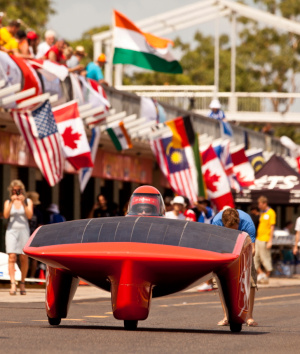Solar car racing refers to competitive races of electric vehicles which are powered by solar energy obtained from solar panels on the surface of the car (solar cars). The first solar car race was the Tour de Sol in 1985 which led to several similar races in Europe, USA and Australia. Such challenges are often entered by universities to develop their students' engineering and technological skills, but many business corporations have entered competitions in the past. A small number of high school teams participate in solar car races designed exclusively for high school students.
The two most notable solar car distance (overland) races are the World Solar Challenge and the North American Solar Challenge. They are contested by a variety of university and corporate teams. Corporate teams participate in the races to give their design teams experience of working with both alternative energy sources and advanced materials. University teams participate in order to give their students experience in designing high technology cars and working with environmental and advanced materials technology.
This race features a field of competitors from around the world who race to cross the Australian continent. In 2005, the Dutch Nuna 3 team won this challenge for a 3rd time in a record average speed of 102.75 km/h over a distance of 3000 km, followed by the Australian Aurora (92.03 km/h) and the University of Michigan (90.03 km/h). The increasingly high speeds of the 2005 race participants has led to the rules being changed for future solar cars starting in the 2007 race.
For the first time there will be four classes. The introduction and creation of these classes has come about through an extensive evaluation phase and feedback from teams that there is a need to introduce classes that allow the event to remain true to its ethos while recognizing the need for elite solar car classes and non-solar electric vehicles.
Challenger Class Solar EVs: - are designed primarily for efficiency rather than comfort or practicality. They need carry a driver only. The winner of the Challenger Class is the first Challenger Class Solar EV to reach Adelaide.
Cruiser Class Solar EVs: - are designed primarily for practicality. They are designed to carry two or more occupants, each facing forwards. They will be judged on external energy use, the time taken to complete the course, the payload carried and practicality
Adventure Class: - is for entry level teams wishing to campaign Solar EVs built for previous International Solarcar Federation events but do not meet the regulations for Challenger Class.
Evolution Class: - is designed for vehicles which have been designed, equipped or modified to demonstrate a significant reduction in environmental impact. These may be practical or concept vehicles that meet the requirements for individually constructed vehicles but not the requirements of the Solar EV classes. The Technical committee will determine the eligibility of any vehicle submitted for the Evolution Class.
 Efficient balancing of power resources and power consumption is the key to success during the race. At any moment in time the optimal driving speed depends on the weather (forecast) and the remaining capacity of the batteries. The team members in the (normal) escort cars will continuously remotely retrieve data from the solar car about its condition and use these data as input for prior developed computer programs to work out the best driving strategy.
It is equally important to charge the batteries as much as possible in periods of daylight when the car is not racing. To capture as much solar-energy as possible, the solar panels are generally directed such that these are perpendicular to the incident sun rays. Often the whole car is tilted for this purpose.
Efficient balancing of power resources and power consumption is the key to success during the race. At any moment in time the optimal driving speed depends on the weather (forecast) and the remaining capacity of the batteries. The team members in the (normal) escort cars will continuously remotely retrieve data from the solar car about its condition and use these data as input for prior developed computer programs to work out the best driving strategy.
It is equally important to charge the batteries as much as possible in periods of daylight when the car is not racing. To capture as much solar-energy as possible, the solar panels are generally directed such that these are perpendicular to the incident sun rays. Often the whole car is tilted for this purpose.
Meanwhile Cambridge University students have designed an electric vehicle which they are confident will win a race across Australia in the World Solar Challenge 2013. One of the students has a unique teardrop design for a possible solar bike.
The thought of a solar bike will be a refreshing change to the array of flat blade designs which dominates the overall aerodynamic designs most of the challengers would use. The new rules allowing the use of electric vehicles of different class may also allow variations in vehicle design. Considering that solar energy can only provide a finite amount of power, squeezing as much power to the wheels is limited to the technology and efficiency.
My own thoughts is that once you get to the top limit of power to drive the wheels, then comes a trade off in its design in reducing drag coefficient. Uniquely, the new rules might allow some radical thinking in power generation and transfers. Consider the use of orbital satellites to transfer power wirelessly, (perhaps in the microwave range). The surface area of the vehicle limits its power generation and ultimately its speed, which seems to be around 91km/h.
Also Under the 40 degree heat of the Australian sun, its possible to try to focus the solar energy into hydrogen production for a efficient combustible/steam engine or using magnifying lenses to boost power generation in the solar cells. The innovation to these competitions, seem to have dried up. Hopefully recent rule changes and student thinking outside the box will allow a leap of faith on a radicle new system which will blow other designs out of the water. In the next World solar change, I wish all the competitors the very best of luck. But I would hope someone would try not to use existing technology in what I think is a sophisticated soap box derby...





This blog is a good one! Its original, thanks for the info! Is there a way I can tell my people about this post. for more info about racing items visit Sold on racing
ReplyDelete